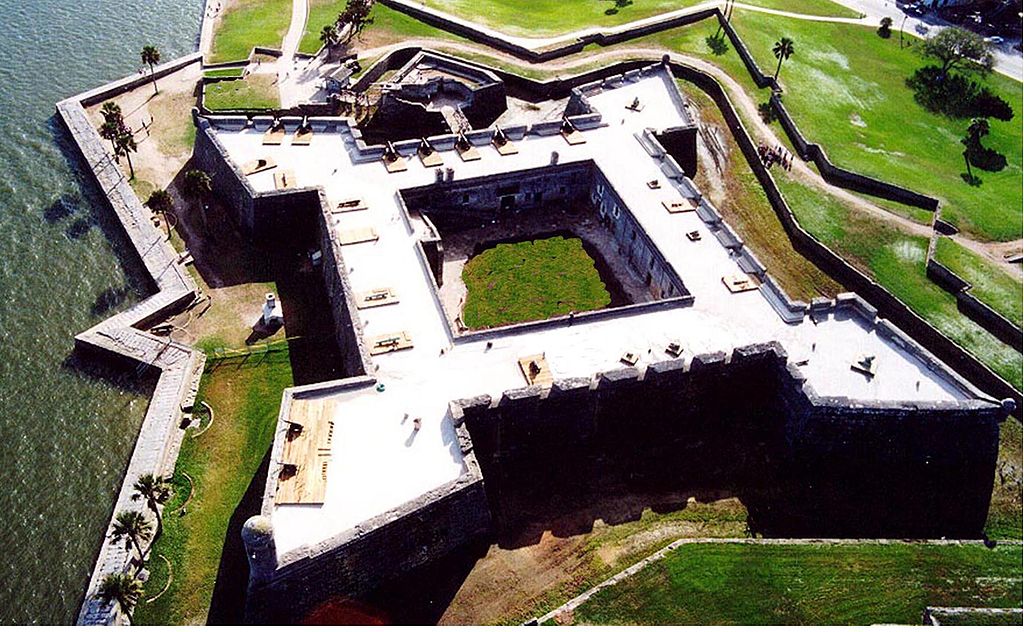By Ariel Thomas| gargoyle@flagler.edu
Climate change threatens the Castillo de San Marcos in St. Augustine and other national landmarks along the coast, but it’s not just seaside treasures that are at risk, experts say.
“I’m really concerned that there’s been so much attention to coastal parks – which have the visible impacts of sea level rise and storm surges – that we’re missing more subtle but ultimately no less or not much less dangerous impacts in the interior,” says Marcy Rockman, climate change adaptation coordinator for Cultural Resources at National Park Service.
Rockman, who spoke earlier this year at Flagler College in St. Augustine, said climate change perils include rain damage on adobe structures in national parks in the Southwestern states, wildfires in the West and flooding in the northern Great Plains.
Alaska is another trouble spot, she said.

Castillo de San Marcos. Photo: Wikipedia
“The evidence is very clear that parks in Alaska are seeing dramatic changes and that cultural heritage – of both current Native Alaskans and records of the past – have already been lost,” Rockman said. “Alaska and the Arctic broadly is what I consider to the ‘blinking red light’ of cultural heritage impacts from climate change.”
Rockman spoke at Flagler College earlier this year as part of the Heritage at Risk series.
The series ended on March 30 with a panel that featured three experts on climate change and cultural resources: Lisa Craig, chief of Historic Preservation in Annapolis; Adrienne Burke, community development director of Fernandina Beach; and Thomas Rupert, a coastal planning specialist of the Florida Keys.
Each panelist took the audience through their own city’s climate journey. Craig said Annapolis, which also sits at sea level, experiences street flooding similar to that in St. Augustine. Her city started a program called Weather it Together to fight sea level rise and tidal flooding.
Burke discussed flooding in Amelia Island, which is only 13 miles long and four miles wide. Historical sites at risk include Fort Cinch, Amelia Island Lighthouse, and the Old Town and downtown historic districts.
The Amelia Island City Comprehensive Plan has recognized danger of sea level rise and has started developing plans to prevent damage.
Rupert said the Florida Keys both historical sites and endangered species are at risk.
The Keys must also deal with nuisance flooding. By the year 2020, Rupert predicts that there will be 20 flooding episodes in the Keys every year.

Marcy Rockman
Rockman also spoke at Flagler as part of the Heritage at Risk series. Later, in an interview, she discussed the impact of climate change on cultural resources, which she said includes “archaeological sites, historic and prehistoric buildings and structures, cultural landscapes, ethnographic resources (which include all of the tangible and intangible resources, knowledge, and practices that support traditional and indigenous cultures), and museum collections.”
She said, “Geological and chemical records clearly show that the global climate has changed profoundly multiple times in the past. The fundamental distinguishing characteristic of our modern climatic change situation is the role of humans in instigating that change. In other words – it’s caused by modern human behavior. Cultural heritage in turn is the record and product of all variations of human behavior on earth to date.”
Rockman said preserving cultural heritage is crucial to our global society, and we should act before it’s too late.
“There isn’t time for us to evolve new physical means of dealing the effects of modern climate change – so we’re going to have to be creative,” she says. “How cultural heritage helps us in this is preserving and illustrating other ways in which humans have lived on the planet and how past humans have dealt with the big environmental changes in their own times. When we can look at the historical, archaeological, and ethnographic records of their history, and see that they shifted their economic systems, or changed the orientation of their settlements, that can give us new ways of looking at our own systems.”
The Heritage at Risk series is associated with the college’s Ideas and Images: Scholars and Artists in Residence program that was conceived by Dr. Alan Woolfolk, vice president of Academic Affairs.
“Heritage at Risk addressed climate change and especially sea level rise as they are global issues that are impacting people on a daily basis,” says Leslee Keys, director of Historic Preservation at Flagler College. “The topic is critical in the US for East Coast cities, such as Newport, Annapolis and St. Augustine, due to the long and significant history of the communities and the amount of development that is being impacted as the oceans warm and rise.”
The series was designed to bring attention to climate and cultural matters to the public that may not be discussed as widely as they should be.
“The purpose is to focus on a topic through a scholarly framework bringing a perspective from national and international experts,” says Keys. “We as the college and community members can gain important knowledge, and the speakers can learn about St. Augustine. The series helped to elevate the importance of St. Augustine’s cultural history being included in the international dialogue on climate change and sea level rise.”
The college plans to sponsor additional Heritage at Risk presentations during the 2016-17 academic year. Dr. David Guggenheim, of the Cuba Conservancy in Washington D.C., is expected to be one of the speakers.
“Sea level rise has been documented in Florida for a century, but, as with the rest of the planet, is increasing much faster than anticipated,” says Keys. “It is the issue of this century.”





Be the first to comment on "Sea level rise endangers cultural resources"